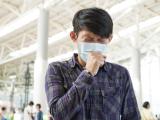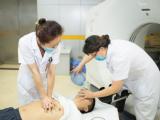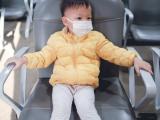Jun 25, 2004 (CIDRAP News) One dose of an experimental intranasal vaccine protected monkeys from the SARS (severe acute respiratory syndrome) virus in a study reported this week, raising hope for a vaccine that could quickly protect healthcare workers in a SARS outbreak.
African green monkeys that received the spray vaccine showed no viral replication after they were exposed to the SARS virus, whereas the virus reproduced in unvaccinated monkeys, according to the report in The Lancet. The study was conducted by Alexander Bukreyev, PhD, Peter Collins, PhD, and colleagues at the National Institute of Allergy and Infectious Diseases (NIAID).
"This study shows that delivering the vaccine directly into the respiratory tract can effectively protect primates from SARS," said Brian R. Murphy, MD, a coauthor of the study, in an NIAID news release. Murphy is co-chief of the NIAID Laboratory of Infectious Diseases.
"With more research, we hope to develop a vaccine based on this approach that could be used to rapidly immunize first responders and other medical personnel, helping them control a potential outbreak," Murphy added.
The researchers created the vaccine by combining a piece of the SARS virus with a weakened version of human parainfluenza virus type 3 (HPIV3), which in its natural form causes respiratory diseases in young children, the NIAID said. The researchers altered the weakened virus, called BHPIV3, by adding a gene for the SARS spike protein, which protrudes from the surface of the SARS virus and enables it to attach to human cells. Using BHPIV3 made it possible to introduce the SARS spike protein directly into the respiratory tract, the NIAID said.
Four monkeys received a nasal spray containing BHPIV3 with the SARS spike protein gene (BHPIV3/SARS-S), while four other monkeys received a version of BHPIV3 containing a harmless gene in place of the SARS gene, according to the NIAID. The monkeys that received the test vaccine developed neutralizing antibodies against the SARS virus, while the control group did not.
The researchers exposed both groups of monkeys to the SARS virus intranasally 28 days after they were vaccinated. The control group subsequently shed SARS virus from the upper and lower respiratory tract, whereas the BHPIV3/SARS-S group did not. The control monkeys showed no signs of illness, but this is not unusual for animals experimentally infected with human viruses and does not invalidate the finding that the vaccine was effective, the authors say in their report.
"The use of this respiratory virus as a vector provides for direct immunization of the respiratory tract, the main site of SARS coronavirus transmission and disease," the researchers state.
In the NIAID release, Murphy said the vaccine in its current form would work best in young children. Most adults have some immunity to HPIV3 from childhood infections, and this would probably hinder an immune response to a SARS vaccine based on HPIV3, he said.
Nonetheless, Murphy and colleagues plan to conduct clinical trials of BHPIV3 and other potential intranasal vaccines. "In the long run, we want to establish a weakened respiratory virus vector that all people are susceptible to," he said. "That way, we can quickly develop vaccines for numerous diseases by simply inserting the protective genes of those viruses into our generalized vector."
In March and April of this year, the NIAID reported promising results from tests of two other SARS vaccines in mice. The BHPIV3/SARS-S vaccine differs from the other two in that it is delivered into the respiratory tract and it requires only one dose instead of two, the agency noted. NIAID Director Anthony S. Fauci, MD, said the three vaccines represent "three technologically unique approaches to restricting SARS replication in animals."
In a Lancet commentary, two writers from Australia say intranasal vaccines made from weakened viruses offer a number of advantages, including the triggering of both systemic and mucosal immune responses. However, A. R. Foxwell and A. W. Cripps add that it is important to determine how long it takes for immunity to develop and how long immunity lasts. They note that in the NIAID study, the serum level of antibodies 28 days after exposure to the SARS virus was no higher in the immunized monkeys than in the control monkeys.
Bukreyev A, Lamirande EW, Buchholz UJ, et al. Mucosal immunization of African green monkeys (Cercopithecus aethiops) with an attenuated parainfluenza virus expressing the SARS coronavirus spike protein for the prevention of SARS. Lancet 2004 Jun 26;363(9427):2122-7 [Summary]
See also:
Jun 24 NIAID news release
Foxwell AR, Cripps AW. Mucosal immunisation and immunoprophylaxis as potential strategies for prevention of SARS. (Commentary) Lancet 2004;363(9427) [Preview]



















